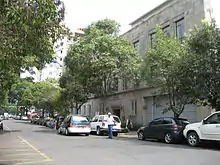Secretariat of Culture
The Secretariat of Culture (Spanish: Secretaría de Cultura), formerly known as the National Council for Culture and Arts (Spanish: Consejo Nacional para la Cultura y las Artes or CONACULTA), is a Mexican government agency in charge of the nation's museums and monuments, promoting and protecting the arts (visual, plastic, theatrical, musical, dance, architectural, literary, televisual and cinematographic), and managing the national archives.
| Secretaría de Cultura | |
|---|---|
| Style | Secretary |
| Member of | Government of Mexico |
| Reports to | President of Mexico |
| Seat | Secretaría de Cultura offices, Paseo de la Reforma, Mexico City |
| Appointer | President of Mexico |
| Term length | No fixed term |
| Precursor | National Council for Culture and Arts, CONACULTA |
| Inaugural holder | Rafael Tovar y de Teresa |
| Formation | December 18, 2015 |
| Website | www.gob.mx/cultura |
It was created in 1988 and was a decentralized body of the Secretariat of Public Education (Spanish: Secretaría de Educación Pública). On December 18, 2015, CONACULTA was elevated to a secretariat following the passage of a law originally promoted three months earlier by President Enrique Peña Nieto.
Diplomat, historian and lawyer Rafael Tovar y de Teresa was the first culture secretary; in office for one year since CONACULTA was elevated to a Cabinet-level position in December 2015 until 10 December 2016, when Tovar y de Teresa died in Mexico city at the age of 62.[1][2]
Subsidiaries

Subsidiaries of the Secretariat of Culture include the Biblioteca Vasconcelos, the National Fund for Culture and the Arts (FONCA), the Instituto Mexicano de Cinematografía, the Instituto Nacional de Antropología e Historia and Instituto Nacional de Bellas Artes y Literatura.
Broadcasting
Upon its creation, the Secretariat of Culture took control of CONACULTA's television station Canal 22, seen on air in Mexico City and relayed by 25 SPR transmitters, as well as Radio Educación, which had previously been part of the SEP. Both stations transmit cultural and educational content.
References
- Ampudia, Mariana (2016-12-10). "El secretario de Cultura Rafael Tovar y de Teresa murió la madrugada de este sábado, a los 62 años de edad". El Economista (Mexico) (in Spanish). Retrieved 2016-12-10.
- "Perfil: Rafael Tovar y de Teresa, primer secretario de cultura". El Universal (Mexico City) (in Spanish). 2016-12-10. Retrieved 2016-12-10.